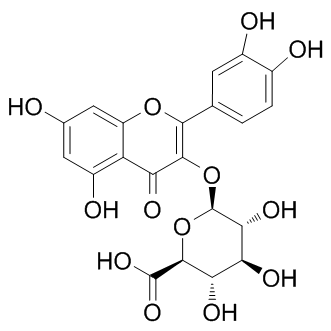All AbMole products are for research use only, cannot be used for human consumption.

In vitro: Miquelianin shows an antioxidant effect in human plasma. At 50 μM, miquelianin suppresses the consumption of the three antioxidants lycopene, β-carotene and α-tocopherol significantly. In vitro studies indicate that miquelianin is able to reach the central nervous system from the small intestine. Miquelianin significantly reduces the generation of β-amyloid (Aβ) peptides by primary neuron cultures generated from the Tg2576 AD mouse model. It is also capable of interfering with the initial protein-protein interaction of Aβ1–40 and Aβ1–42 that is necessary for the formation of neurotoxic oligomeric Aβ species. Treatment with 0.1 μM miquelianin suppresses ROS generation, cAMP and RAS activation, phosphorylation of ERK1/2 and the expression of HMOX1, MMP2, and MMP9 genes. Miquelianin suppresses invasion of MDA-MB-231 breast cancer cells and MMP-9 induction, and inhibits the binding of [3H]-NA to b2-AR. Miquelianin may function to suppress invasion of breast cancer cells by controlling b2-adrenergic signaling, and may be a dietary chemopreventive factor for stress-related breast cancer. In vivo: Miquelianin treatment, compared to vehicle-control treatment, significantly improves AD-type deficits in hippocampal formation basal synaptic transmission and long-term potentiation. A flavonoid fraction obtained from a crude extract of Hypericum perforatum (St. John's wort) is remarkably active in the forced swimming test. Miquelianin is one of the compound separated from the fraction.
| Cell Experiment | |
|---|---|
| Cell lines | 14–16 corticohippocampal neuronal |
| Preparation method | Freshly isolated low-molecular-weight Aβ1–42 (25 μM) or Aβ1–40 (25 μM) peptide (18 μl) was mixed with 1 μl of 1 mm tris-(2,2′-bipyridyl)dichlororuthenium(II) [Ru(Bpy)] and 1 μl of 20 mM ammonium persulfate in the presence or absence of 25 μM quercetin-3-O-glucuronide in 10 mM phosphate. |
| Concentrations | 25 μM |
| Incubation time | |
| Animal Experiment | |
|---|---|
| Animal models | Tg2576 mice |
| Formulation | |
| Dosages | |
| Administration | |
| Molecular Weight | 478.36 |
| Formula | C21H18O13 |
| CAS Number | 22688-79-5 |
| Form | Solid |
| Solubility (25°C) | 30 mg/mL in DMSO |
| Storage |
Powder -20°C 3 years ; 4°C 2 years In solvent -80°C 6 months ; -20°C 1 month |
| Related Metabolite/Endogenous Metabolite Products |
|---|
| D-Tryptophan
D-Tryptophan is the D-isomer of tryptophan, as a non-protein active amino acid, has special physiological properties, can be used as additives, plant growth agents, etc. In the pharmaceutical industry, it is mainly used in the synthesis of various polypeptides, instead of L-tryptophan to extend the peptide half-life. |
| Arachidonic acid sodium salt
Arachidonic acid sodium salt (Sodium Arachidonate) is a polyunsaturated omega-6 fatty acid and a major constituent of biomembranes. Arachidonic acid sodium salt also acts as the substrate for various lipid mediators, such as prostaglandins (PGs). |
| trans-Vaccenic acid
trans-Vaccenic acid is a naturally occurring trans fatty acid (TFA). trans-Vaccenic acid is a precursor for the synthesis of saturated fatty acid in the rumen and of conjugated Linoleic acid (CLA) at the tissue level. trans-Vaccenic acid inhibits nasopharyngeal carcinoma (NPC) cell growth and induces apoptosis through the inhibition of Bad/Akt phosphorylation. |
| Mead acid
Mead acid (5,8,11-Eicosatrienoic acid) is an unsaturated (Omega-9) fatty acid. |
| p-Cresol glucuronide
p-Cresol glucuronide is a metabolite of p-cresol, it is a prototype protein-bound uremic toxin. |
All AbMole products are for research use only, cannot be used for human consumption or veterinary use. We do not provide products or services to individuals. Please comply with the intended use and do not use AbMole products for any other purpose.


Products are for research use only. Not for human use. We do not sell to patients.
© Copyright 2010-2024 AbMole BioScience. All Rights Reserved.
